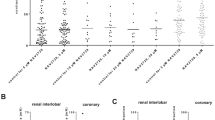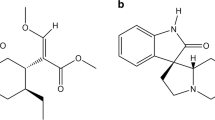Summary
The mean membrane potential of smooth muscle cells of the rabbit main coronary artery was-60.3 mV and an evoked action potential could be recorded in response to acetylcholine (ACh). Ergonovine or 5-hydroxytryptamine (5-HT) slightly depolarized the membrane and methysergide, a relatively selective antagonist for the 5-HT receptor, had a slight inhibitory action on these depolarizations. 5-HT produced larger contractions than ergonovine, and the concentration-effect relationships obtained for both agents shifted to higher concentrations following pre-equilibration with methysergide. ACh (10−11 M) slightly hyperpolarized the membrane and relaxed the tissue, and high concentrations of ACh (>10−8 M) depolarized the membrane, increased the membrane resistance and produced a contraction. ACh but not ergonovine or 5-HT, produced a contraction in Ca-free EGTA-containing solution. Following a 60 min pre-equilibration with indomethacin, the ergonovine-induced contraction was markedly enhanced but the 5-HT-or ACh-induced contractions were not. Removal of the endothelium by rubbing the vascular lumen enhanced the ergonovine-or ACh-induced contractions, but not those to 5-HT.
The results obtained can be summarized as follows: ergonovine probably accelerates Ca influx and thereby produces contraction in the rabbit main coronary artery. This contraction is due to activation of the 5-HT receptor as an agonist, but the ergonovine-induced contraction is attenuated due to activation of the endothelium from which inhibitory prostanoid substances may be released. Ergonovine, therefore, may produce greater contractions in coronary arteries with damaged endothelium than in intact tissues.
Similar content being viewed by others
References
Abe Y, Tomita T (1968) Cable properties of smooth muscle. J Physiol 196:87–100
Apperley E, Feniuk W, Humphrey PPA, Levy GP (1980) Evidence for two types of excitatory receptor for 5-hydroxytryptamine in dog isolated vasculature. Br J Pharmacol 68:215–224
Bacq ZM (1934) La pharmacologie du systeme nerveux autonome, et particulierement du sympathique, d'apres la theorie neurohuomorale. Annu Rev Physiol 10:468–528
Brazenor RM, Angus JA (1981) Ergometrine contracts isolated canine arteries by a serotonergic mechanism: No role for α-adrenoceptors. J Pharmacol Exp Ther 218:530–536
Brazenor RM, Angus JA (1982) Actions of serotonin antagonists on dog coronary artery. Eur J Pharmacol 81:576–596
Carroll PR, Glover WE (1973) Independence of the vasoconstrictor and the potentiating effects of 5-hydroxytryptamine and some ergot derivatives. Proc Aust Physiol Pharmacol Soc 4:40
Cipriano PR, Guthaner DF, Orlick AE, Ricci DR, Wexler L, Silverman JF (1979) The effects of ergonovine maleate on coronary arterial size. Circulation 59:82–89
Curry RC, Popine CJ, Sabom MB, Conti CR (1979) Similarities of ergonovine-induced and spontaneous attacks of variant angina. Circulation 59:307–312
DeMey JG, Vanhoutte PM (1981) Role of the intima in cholinergic and purinergic relaxation of isolated canine femoral arteries. J Physiol 316:347–355
DeMey JG, Vanhoutte PM (1982) Heterogeneous behavior of the canine arterial and venous wall. Importance of the endothelium. Circ Res 51:439–447
Dyer DC, Gant DW (1973) Vasoconstriction produced by hallucinogens on isolated human and sheep umbilical vasculature. J Pharmacol Exp Ther 184:366–375
Fozard JR (1976) Comparative effects of four migraine prophylactic drugs on an isolated extracranial artery. Eur J Pharmacol 36:127–129
Fozard JR, Berry JL (1976) Interactions between antimigraine drugs and a high affinity uptake and storage mechanisms for 5-hydroxy-tryptamine. Pharmacology 14:357–361
Furchgott RF (1954) Dibenamine blockade in strips of rabbit aorta and its use in differentiating receptors. J Pharmacol Exp Ther 111:265–284
Furchgott RF, Zawadzki JV (1980) The obligatory role of endothelial cells in the relaxation of arterial smooth muscle by acetylcholine. Nature 288:373–376
Furchgott RF, Zawadzki JV, Cherry PD (1981) Role of endothelium in the vasodilator responses to acetylcholine. In: Vanhoutte PM, Leusen I (eds) Vasodilation. Raven Press, Basel New York, pp 107–121
Gaddum JH (1953) Antagonism between lysergic acid diethylamide and 5-hydroxytritamine. J Physiol 121:15
Gerova M, Barte E, Gero J (1979) Sympathetic control of major coronary artery diameter in the dog. Circ Res 44:459–467
Henry PD, Yokoyama M (1980) Supersensitivity of atherosclerotic rabbit aorta to ergonovine mediation by a serotonergic mechanism. J Clin Invest 66:306–313
Hirst GDS, Neild TO (1980) Noradrenergic transmission-reply to McGrath. Nature 288:301–302
Hirst GDS, Neild TO (1981) Localization of specialized noradrenaline receptors at neuromuscluar junctions on arterioles of the guinea-pig. J Physiol 313:343–350
Hodgkin AL, Rushton WHA (1946) The electrical constants of crustacean nerve fibre. Proc R Soc Lond [Biol] 133:444–479
Holman ME, Surprenant AM (1979) Some properties of the excitatory junction potentials recorded from saphenous artery of rabbit. J Physiol 287:337–351
Ito Y, Kitamura K, Kuriyama H (1979) Effects of acetylcholine and catecholamines on the smooth muscle cell of the porcine coronary artery. J Physiol 294:565–611
Ito Y, Kitamura K, Kuriyama H (1980) Nitroglycerine and catecholamine actions on smooth muscle cells of the canine coronary artery. J Physiol 309:171–183
Itoh T, Kitamura K, Kuriyama H (1983) Roles of extrajunctional receptors in the response of guinea-pig mesenteric and rat tail arteries to adrenergic nerves. J Physiol 345:409–422
Kitamura K, Kuriyama H (1979) Effects of acetylcholine on the smooth muscle cell of isolated main coronary artery of the guinea-pig. J Physiol 293:119–133
Kuriyama H, Makita Y (1983) Modulation of noradrenergic transmission in the guinea-pig mesenteric artery: an electrophysiological study. J Physiol 335:609–628
Kuriyama H, Suzuki H (1978) The effects of acetylcholine on the membrane and contractile properties of smooth muscle cells of the rabbit superior mesenteric artery. Br J Pharmacol 64:493–501
Langer SZ (1977) Presynaptic receptors and their role in the regulation of transmitter release. Br J Pharmacol 60:481–497
Mohrman DE, Feigl EO (1978) Competition between sympathetic vasoconstriction and metabolic vasodilation in the canine coronary circulation. Circ Res 42(1):79–86
Müller-Schweinitzer E (1980) The mechanism of ergometrine-induced coronary arterial spasm: In vitro studies on canine arteries. J Cardiovasc Pharmacol 2:645–655
Müller-Schweinitzer E (1983) Vascular effects of ergot alkaloids: A study on human basilar arteries. Gen Pharmacol 14:95–102
Müller-Schweienitzer E, Brundell J (1975) Enhanced prostaglandin synthesis contributes to the venoconstrictor activity of ergotamine. Blood Vessels 12:193–205
Müller-Schweinitzer E, Stürmer E (1974) Investigations on the mode of action of ergotamine in the isolated femoral vein of the dog. Br J Pharmacol 51:441–446
Porquet MF, Pourrias B, Santamaria R (1982) Effects of 5-hydroxytryptamine on canine isolated coronary arteries. Br J Pharmacol 75:305–310
Prinzmetal M, Kennamer R, Merliss R, Wada T, Bor N (1959) Angina pectoris. I. A variant form of angina pectoris. Am J Med 27:275–288
Sakanashi M, Yonemura K (1980) On the mode of action of ergometrine in the isolated dog coronary artery. Eur J Pharmacol 64:157–160
Schönbaum E, Vargaftig NB, Lefort J, Lamer JC, Hasenack T (1975) An unexpected effect of serotonin antagonists on the canine nasal circulation. Headache 15:180–187
Vanhoutte PM (1981) Why is acetylcholine a vasodilator? Vanhoutte PM, Leusen I (eds) Vasodilation. Raven Press, Basel New York, pp 67–72
Vanhoutte PM, DeMey J (1983) Control of vascular smooth muscle function by the endothelial cells. Gen Pharmacol 14:39–41
Vanhoutte PM, Verbeuren TJ, Webb RC (1981) Local modulation of the adrenergic neuroeffector interaction in the blood vessel wall. Physiol Rev 61:151–247
Van Nueten JM (1983) 5-Hydroxytryptamine and precapillary vessels. Fed Proc 42:223–227
Van Nueten JM, Janssen PAJ, De Ridder W, Vanhoutte PM (1982) Interaction between 5-hydroxytryptamine and other vasoconstrictor substances in isolated femoral artery of the rabbit; effect of ketanserine (R 41468). Eur J Pharmacol 77: 281–287
Yokoyama M, Henry PD (1979) Sensitization of isolated canine coronary arteries to calcium ions after exposure to cholesterol. Circ Res 45:479–486
Zuberbühler RC, Bohr DF (1965) Responses of coronary smooth muscle to catecholamines. Circ Res XVI:431–440
Author information
Authors and Affiliations
Rights and permissions
About this article
Cite this article
Suyama, A., Kuriyama, H. Mechanisms of the ergonovine-induced vasoconstriction in the rabbit main coronary artery. Naunyn-Schmiedeberg's Arch. Pharmacol. 326, 357–363 (1984). https://doi.org/10.1007/BF00501443
Received:
Accepted:
Issue Date:
DOI: https://doi.org/10.1007/BF00501443




